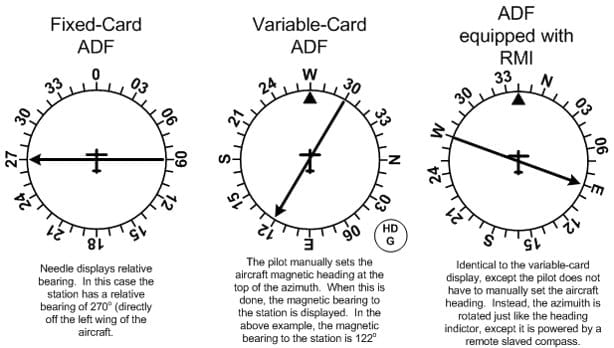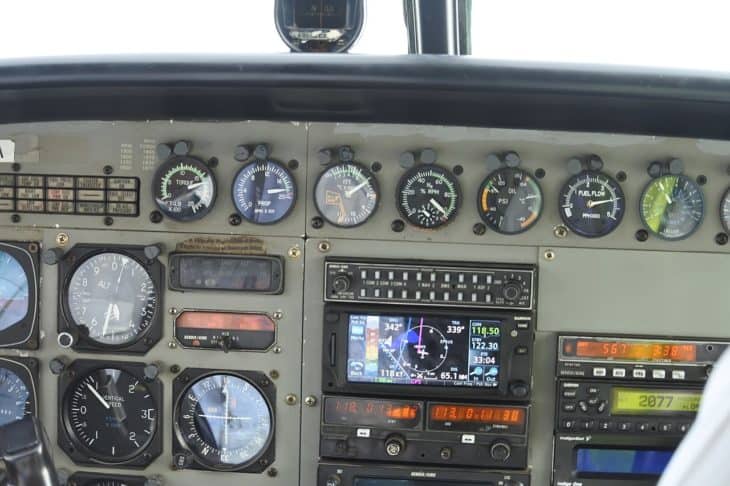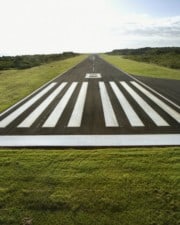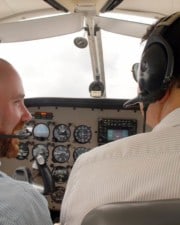Now a dying technology, ADF-based navigation was once the foundation of the airspace system. VORs eventually replaced it and, more recently, it has been made nearly obsolete by GPS satellite navigation.
ADF stands for automatic direction finder. Based on simple AM-radio ground stations called NDBs (non-directional beacons), an ADF is an aircraft instrument with a directional arrow-shaped pointer. The arrow simply points straight at the programmed NDB’s position in relation to the aircraft.
ADF Basic Usage
To use an ADF, the pilot begins by selecting the station with which they want to navigate. Station frequencies are in the AM bandwidth, from 190 to 1750 kHz. They are described as low or medium-frequency. NDBs are described in Chapter 1-1-2 of the Aeronautical Information Manual (AIM).
NDBs can be used just like VORs are to define an airway. There are still a few “low-frequency airways” around. While VOR airways are known as Victor Airways, with designations like V-3, NDB airways are known as colored airways. For example, B646 (Blue 646) crosses from Mexico to The Bahamas through the Florida Keys and G13 (Green 13) lies along the Outer Banks of North Carolina.
Commercial AM radio stations also transmit on a similar frequency range, from 540 to 1600 kHz. An ADF in the aircraft can receive AM radio stations, and they can even be used to navigate.

The second step is to verify that the station is transmitting and properly selected. The audio panel is used to listen to the station’s audio transmission, which should be a morse code station identification. Unlike VORs, NDBs do not have a flag to indicate if a station goes off the air. That necessitates the constant monitoring of the morse code identification while using an NDB as the only source of navigation.
Monitoring the audio transmissions from the beacon will also alert the pilot to any potential interference with the navigational signal. Anything that affects it will be evident in the audio as well.
ADF Terminology
When viewed from the cockpit, the ADF instrument has a face that displays the number of degrees from 0 at the top to 359 going clockwise. The needle points at the relative bearing to the NDB, which is read in degrees from the dial. An NDB with a relative bearing of 90 degrees lies off the right wingtip, while one with a relative bearing of 180 is directly behind the aircraft.
Relative bearing alone is not an overly significant number. What the pilot wants to know to navigate to the station successfully is the magnetic bearing. That would be the heading he or she should fly to get directly to the NDB. The formula magnetic bearing = relative bearing + magnetic heading gets the answer.
For example, if the aircraft is flying heading 090 degrees, and the ADF indicates a relative bearing of 090 degrees, then the magnetic bearing to the station is 090 + 090 = 180 degrees. In this example, the plane lies due north of the station headed east. It would need to fly due south to get to the NDB.
The magnetic bearing from a station can also be found simply by referencing the tail of the needle. In the same example as above, the tail is pointing to a relative bearing of 270 degrees. 270 + 090 = 360 degrees is the magnetic bearing to fly directly away from the station.
Problems with NDB Navigation
NDBs are still in service all over the world. The equipment is cheap to operate, and since it works on low-frequency radio waves, it can travel several hundred miles. It’s not usually limited to line of sight transmissions like VHF radios and NAVAIDs are. Because of this, they are often used in remote areas.
But the technology is antiquated, and the current FAA policy is not to repair or replace NDB stations as they break down from old age.
Even when they were new and working correctly, NDBs were not without shortcomings. The simplicity of the ADF instrument was part of the problem. Since the ADF does not lock onto a selected radial as a VOR does, it’s up to the pilot to carefully monitor the relative bearing and, even more importantly, get the math right. Whether warranted or not, ADFs are the banes of student pilots everywhere.
Wind causes some problems for the NDB airway tracking pilot. With a VOR, when the radial is selected, it is evident when the airplane drifts off course. But with an ADF, the indicator only moves a few inconspicuous degrees. The unsuspecting pilot may then correct his course a few degrees to get the relative bearing back to zero. The result is a continually changing correction into the wind and curved path towards the station. This erroneous method is known as homing to the station.
The correct way to track to a station is to apply a proper wind correction angle, precisely as a pilot would when flying a Victor airway. A crab angle into the wind is found that will stop needle movement, and then double that amount of wind correction is applied. With this method, the aircraft should remain on a constant magnetic bearing to the station the entire way.
This may sound like a small thing to master, but doing so is vitally important for an instrument pilot. NDB instrument approaches require the pilot to track the final approach course carefully, and homing to or from the station with no wind drift correction will lead the unsuspecting pilot dangerously off course.
Types of ADF Display
The ADF instrument described above is known as a fixed-card ADF.

A simple upgrade to this is the moveable-card ADF. A selector knob on the instrument allows you to move the degree card behind the needle. With this in mind, the pilot can set their magnetic heading at the top. The instrument then does the math on its own. The needle now points to the magnetic bearing.
The problem with the moveable-card type instrument is that it is entirely manual. It requires a pilot action every time the aircraft’s heading is changed. But it reduces confusion and makes the entire process simpler to understand.
An even better option is the RMI, or remote magnetic indicator. This instrument combines three elements: a fluxgate compass, a heading indicator, and the ADF instrument. The result is one instrument that always shows magnetic heading and magnetic bearing to the station.
Most RMIs have two indicator needles and the ability to select the source for those needles. These RMI can use NDBs or VORs as navigation sources. If using a VOR, it will work identically to an NDB.
Low-Frequency Problems
The NDB stations themselves have significant limitations as well. There are four primary errors caused by various sources of interference.
Ionosphere error is caused by the radio waves bending off of the ionosphere. This causes the ADF needle to fluctuate. It’s most commonly a problem around sunset and sunrise.
Electrical interference also causes ADF problems. Thunderstorms, in particular, can cause erroneous readings as can other radio transmissions.
Terrain like mountains can reflect and bend radio waves, causing errors.
The final error results from the aircraft itself, particularly in banks. This bank error can cause problems with the ADF momentarily when in turns.
ADF Replacement Technologies
Once the backbone of the airspace system, NDBs are now on their way out. They are still around, and many training aircraft still have ADFs installed.
Perhaps more importantly, learning how to use an ADF gives pilots a historical perspective and helps them master their situational awareness. NDBs are found in other parts of the world, especially in remote areas of the Caribbean, Canada, South America, and some even parts of Europe and Asia.
VORs eventually replaced NDBs as the basis of the US National Airspace System. FAA’s Nexgen Program is designed to take this one step further. Now, GPS satellite-based navigation is becoming the new backbone of the system. VORs are being decommissioned in favor of direct RNAV/GPS routes.
Related Posts














